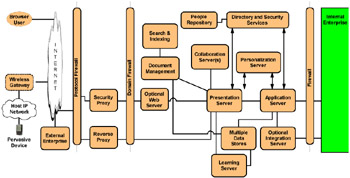4.6 Reflection on ODW
|
| < Day Day Up > |
|
4.6 Reflection on ODW
Throughout this chapter we have referred to a broad category of portal solutions that can be characterized as On Demand Workplaces. Mining the assets from solution architectures such as IFB and deriving generic "large reusable assets" can be a valuable activity. Here we describe a first cut at an ODW composite pattern. We highlight this asset by showing generic use cases and mandatory business, integration, and application patterns, and provide a composite runtime pattern.
4.6.1 ODW generic use cases
The following generic use cases have been identified for an ODW composite pattern. Here we only show those use cases that are in addition to the generic use cases associated with the Portal composite pattern:
-
View Syndicated Content
-
Access from PDA
-
Access eHR System
-
View Corporate Information
-
Manage Customer Accounts
-
Manage Supplier Accounts
-
Do Online Training
-
Access Help Desk
-
View Analytic Data
In the IFB case study considered in this chapter, several of these generic use cases appear. In fact, had we had a reference (ODW) architecture, the following additional use case matches would appear:
| Solution Use Case | ODW generic Use Case |
|---|---|
| Access Customer Service Content | Access Help Desk |
| Update Personnel Record | Access eHR System |
| Employee e-learning | Do Online Training |
| Receive and Audit Inventory | Access from PDA (partial) |
From the generic use cases, we see the following additional mandatory application patterns:
-
Access Integration::Pervasive Device Access (required by Access from PDA)
-
Access Integration::Extended Single Sign-On (typically required by Access eHR)
-
Collaboration::Directed Collaboration (several ODW collaboration services)
Many specific ODW solutions will incorporate Application Integration patterns, but in this initial cut we are keeping it as an optional integration pattern for the ODW composite pattern. This is also shown in the ODW runtime pattern with an optional integration server. The other optional configuration in this pattern is the presence of a security proxy in the DMZ (typical), with the Web server in the trusted network. [4] The resulting runtime is very similar to the IFB runtime pattern (Figure 4-19).

Figure 4-19: ODW composite runtime pattern
There is ongoing work within IBM to formalize this ODW composite pattern and further establish additional work products as well as design guidelines/best practices to support it. Mining a composite pattern from a solution has only been presented informally in this publication. It should be noted that this "leap" was based on extensive work not shown here, where a recurring set of functional requirements and use cases appeared in multiple On Demand Workplace solutions developed within IBM. Pattern mining in general requires observation of such patterns appearing in multiple solutions.
The existence of a formal ODW "solution asset" could have been used as the large reusable asset for the IFB solution development process. In such a scenario, a larger portion of our solution could have been seeded from this (ODW) large reusable asset.
[4]Alternatively, the Web server could move to the DMZ with or without the security proxy.
|
| < Day Day Up > |
|
EAN: 2147483647
Pages: 82